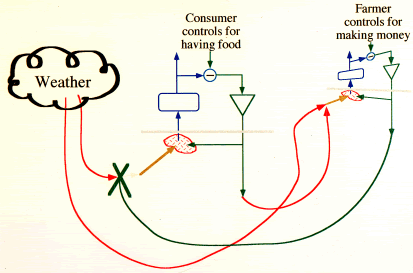|
Here is a real-world example. One possible perception
controlled by a person might be to perceive oneself as having food. If
there were no farmers, and everyone grew their own food, that perception
would be greatly disturbed by the vagaries of the weather. Another perception
that people might control is to have money. Farming is (or used to be)
a way to influence the amount of money one has. By growing and selling
food, the farmer controls a perception of having money.
A side-effect of the farmer's control of the "having money"
perception is that (by means of various other people controlling other
perceptions) food appears in stores. The consumer has a means of controlling
a perception of having food that is less subject to the vagaries of the
weather than is home gardening.
|
 |
|
The weather still can disturb the consumer's control of the "having
food" perception, since it affects the price of food in the store.
But the weather has much less disturbing effect on the consumer's ability
to have food than it would if the farmer were not controlling for having
money.
The influence of each control system on the other is through side-effects.
The farmer cannot perceive any one consumer, and therefore cannot control
any perception related to the consumer. An outside analyst may observe
both farmer and consumer, and may note that if the farmer does not produce
what the consumer wants, the consumer will not buy, but all the farmer
can see of this is that some crops are more effective than others in bringing
in money. According to PCT, the farmer is likely to reorganize
to increase the financial effectiveness of crop production. The consumer,
meanwhile, cannot perceive the farmer, and buys food rather than growing
it because that is a more effective way of controlling the "having
food" perception--it takes less time, perhaps, and it certainly is
less disturbed by variations in the weather.
Farmer and consumer are, in a way, bound together by the side-effects
of each other's control mechanisms. If either stopped controlling those
perceptions, or started to control them by other means (such as the farmer
giving up farming and starting to work on an assembly line making cars
to get money), the other would find it much more difficult to control
their own perception. But neither directly perceives the effects on the
other of their control actions, and therefore the effects are pure side-effects.
It is through these and similar side-effects that society as a whole hangs
together.
|





